Sorry, nothing in cart.
A penile fracture happens when the penis bends or gets hit while erect. This injury causes a tear in the protective tissue. It often occurs during intimate moments and can be quite painful.
After hearing a loud cracking sound, you may suddenly lose your erection. Despite being unusual, this condition is severe and needs immediate medical attention.
Erectile dysfunction and other chronic problems can occur if treatment is not received. Some might see it as a small injury, but it needs quick care to prevent lasting harm.
Understanding Penile Anatomy
The penis’s structure and function are essential to male sexual health. Here’s an overview of its key parts.
Basic structure
The penis has three main parts: the tip, shaft, and root. It contains the urethra, a tube for urine and semen.
Corpora cavernosa
Inside the shaft of the penis, there are two erectile tissues. When a person gets excited, they fill with blood, which causes the penis to firm and erect.
Tunica albuginea
It is a tough layer that surrounds the corpora cavernosa. When the penis is erect, it helps the penis stay firm and maintain its shape.
Urethra
The urethra is a tube that is part of the penis. It transports urine and sperm outside of the body.
When excited, blood rushes into the penis and the corpora cavernosa. This helps blood pressure and makes the penis stiff and erect. An erect penis runs a higher risk of harm due to the increased blood flow and pressure. A quick strike or shock may cause injury, such as a penile fracture.
What Is a Penile Fracture?
A penile fracture is a rip in the tunica albuginea. The penis’s corpora cavernosa are wrapped in a tough, boneless sheath. It is a soft tissue injury, which often happens when the erect penis is bent suddenly.
This may result in sharp pain, a loud “crack” sound, and sudden loss of erection. The inner layer has ruptured, as indicated by the word “fracture.”
About 1 in 175,000 men worldwide suffer a penile fracture, making them highly unusual. of cases occur during intimacy, with the age group most affected being 30 to 50.
Other causes include manual manipulation, rolling over, or accidents, such as toilet injuries. Early surgical treatment is usually recommended, as studies show it leads to fewer complications than delayed or non-surgical care.
Causes and Risk Factors
A penile fracture, though rare, can occur during mishaps. Knowing the main causes and key risk factors helps you avoid this injury.
Vigorous intercourse
Rough or vigorous sex typically causes about 76% of cases. Some positions can increase the risk, especially those that require a lot of force.
Manual trauma
Masturbation or bending an erect penis causes about 10–15% of cases. Forceful manipulation during an erection can easily tear the tunica albuginea.
Rolling over
Sometimes while you sleep, you might roll onto your erect penis. This can cause a painful injury. About 5% of penile fractures occur in this manner.
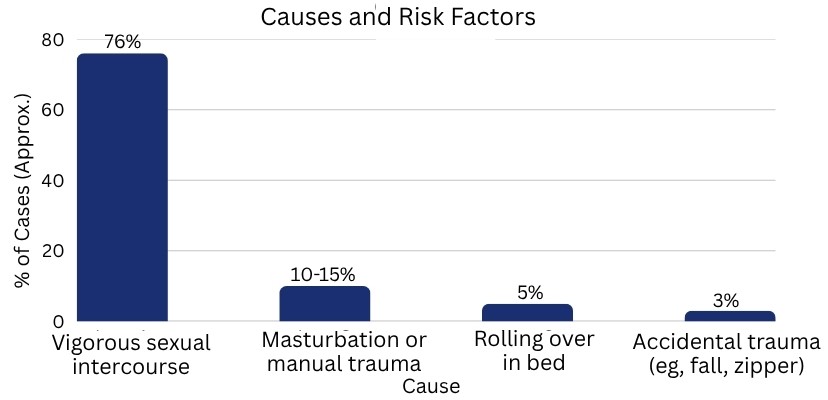
Other trauma
Accidents like falls or catching the penis in a zipper make up roughly 3% of cases. They are less frequent but still a risk, particularly for older men and children.
Use of vacuum devices
Using vacuum pumps or other PDE5 inhibitors may increase the risk of injury due to causing erections that are prone to becoming too rigid.
Symptoms of a Broken Penis
A penis fracture is a rare, serious injury caused by forceful hits or bends. Here’s what to look for:
What Happens During a Penile Fracture?
Sudden trauma can tear the internal tissue of the penis. This results in a penile fracture, leading to pain and swelling. It may also cause long-term issues.
Can a Penile Fracture Cause Erectile Dysfunction (ED)?
Yes, a penile fracture can lead to erectile dysfunction (ED). The injury damages crucial structures, including the tunica albuginea and corpora cavernosa.
This can lead to restricted blood flow, which severely impacts erection strength. If left untreated, it can result in scar tissue, penile curvature, or fibrosis.
ED can also worsen due to psychological effects like fear and anxiety.
According to studies, ED rates vary from 0.6% (El Atat et al.) to as high as 44.4% (Patil et al.), depending on the treatment method and timing of the injury.
Erectile Dysfunction (ED) After Penile Fracture
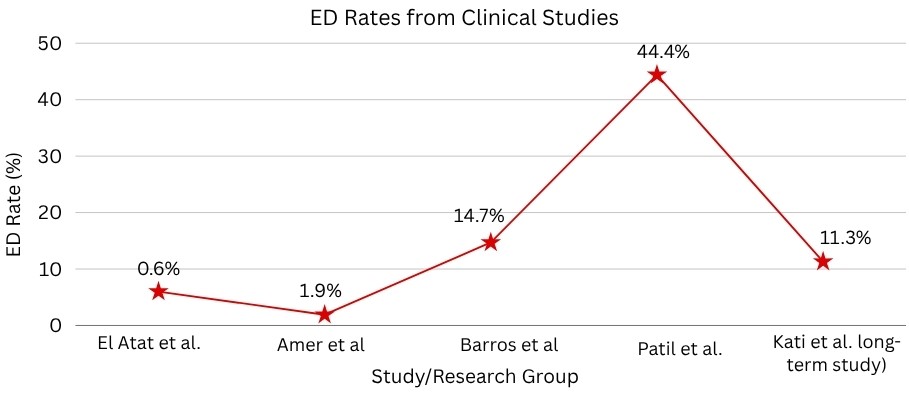
ED after a penile fracture depends on several factors. ED rates typically decrease from 0% to 12% within 24 hours after surgery. Delaying surgery, however, can raise the risk by roughly 10% to 20%.
The risk of ED is highest with conservative treatment, ranging from 22% to 80%. It can increase by 60% with larger tears, being over 50, urethral injuries, and conditions like diabetes.
In one study, the ED rate for surgical repair was only 0.6%, but in another, it was 44.4%.
Diagnosis of Penile Fracture
To diagnose a penile fracture, begin with the patient’s medical history and a physical examination. Imaging is then used to confirm where the tear is and to check for additional damage, especially to the urethra.
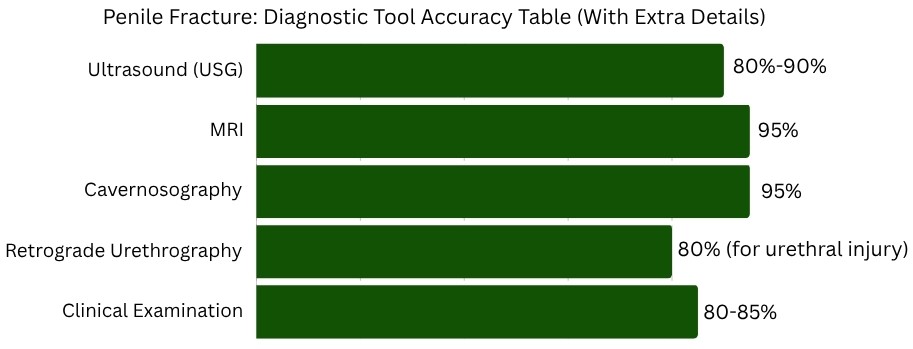
Clinical Signs
The first step is to perform a physical examination, in which doctors search for “eggplant deformity,” swelling, and bruising. This is the main diagnostic step, with an accuracy of about 80–85%. However, it still needs confirmation through imaging.
Ultrasound (USG)
Ultrasound stands out as the top pick for imaging. It’s quick and easy to receive real-time images that matter. Doctors have confidence in the accuracy of 86% to 90%.
MRI and Cavernosography
MRI is often the best option, being right about 95% of the time. Doctors turn to it when an ultrasound doesn’t give clear answers. Cavernosography has the same 95% accuracy, but it’s invasive, so doctors use it now.
Urethral Injury Check
If there’s blood at the urethral opening or trouble urinating, retrograde urethrography can help. It has 80% accuracy for urethral injuries, which occur in 38% of penile fracture cases.
Emergency Treatment Options
Getting quick treatment for a penile fracture can lower the chances of long-term issues. These issues may include erectile dysfunction and scarring later on.
Early Surgery
Surgery within 24 hours gives the best results, with an ED rate of about 7.8%. Some studies suggest that repairs within 8 hours may reduce the risk of ED to below 5%.
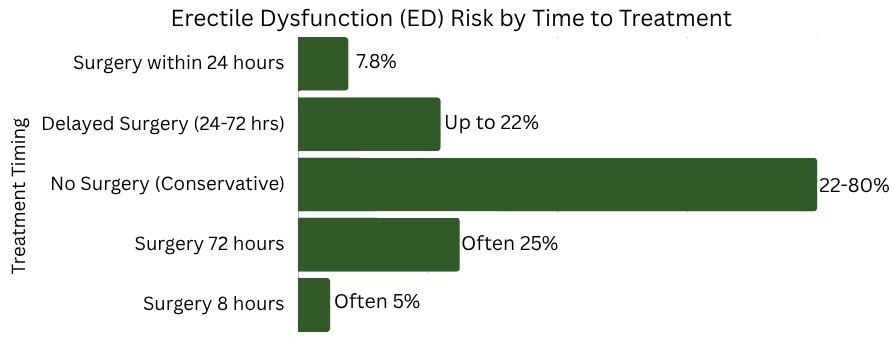
The torn tunica is fixed through a small incision. Most cases use the subcoronal degloving method. Healing is generally good with proper abstinence and follow-up.
Waiting 24 to 72 hours can raise the ED risk to 22%. After 72 hours, the risk goes over 25%. No surgery has the worst outcomes, with ED in 22% to 80% of patients.
Medications Aftercare
Sildenafil (Viagra) and Tadalafil (Cialis) revolutionize treatment for erectile dysfunction. These PDE5 inhibitors ensure stronger erections after surgery. Our study’s conclusive results show that 36 patients overcame ED and regained confidence and vitality.
Recovery and Rehabilitation
To recover from penile fracture surgery, stick to your doctor’s guidelines.
Recovery Timeline
The journey to recovery usually takes around 4 to 6 weeks. Regular follow-ups track healing progress and ensure steady blood flow for a smooth recovery.
Pain Management and Wound Care
The doctor will prescribe painkillers and antibiotics, such as sildenafil and Cialis, to help you manage your condition. Take them as instructed for a smooth recovery.
Resuming Sex and Normal Activities
It’s best to wait at least a month before resuming sexual activity. Consult your doctor to find out the safe time for your return to normal activities.
Potential Complications
Surgery is effective for most people, but it may have side effects. These can include erectile dysfunction or penile curvature. Discuss risk management with your doctor.
Erectile Dysfunction Treatment After Penile Fracture
Some men may have ongoing ED after surgery to repair the fracture. It’s important to assess how serious the condition is and to develop a suitable treatment plan.
Medications
To tackle ED, medications like sildenafil (Viagra), tadalafil (Cialis), and vardenafil help. These medicines improve blood flow to the penis, bringing back a pleasurable sex life.
Counseling or therapy for psychological factors
Psychological factors can also cause erectile dysfunction. Therapy, especially counselling, provides valuable support. It helps with anxiety and depression, boosting confidence and sexual performance.
Surgical options
When other treatments don’t succeed, penile implants can assist. These devices help men restore their ability to achieve an erection when nothing else works.
What Happens If You Don’t Treat It?
If a penile fracture isn’t treated, it can cause serious problems in the long run. Treatment should happen early to prevent complications with sex and urination.
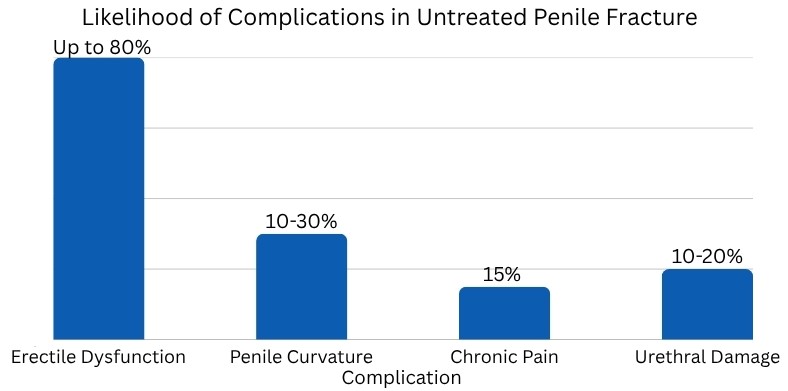
Can You Prevent a Penile Fracture?
Taking certain steps can minimize the risk of a penile fracture. Here’s how:
When to Seek Help
Injuring your penis, especially when it’s erect, is a serious situation that requires immediate attention. You should seek medical help right away. If you delay treatment, it can lead to long-term problems, even if talking about it feels awkward or embarrassing.
Conclusion
Penile fracture is a serious injury, but it’s treatable with prompt medical care. Right after the injury, seeking help is vital to prevent long-term problems like erectile dysfunction.
Certain medications, like PDE5 inhibitors such as and Cialis, can aid in restoring erections after treatment. Watch for signs and act quickly to boost results and restore normal function.
Quick treatment can also stop long-term damage.
